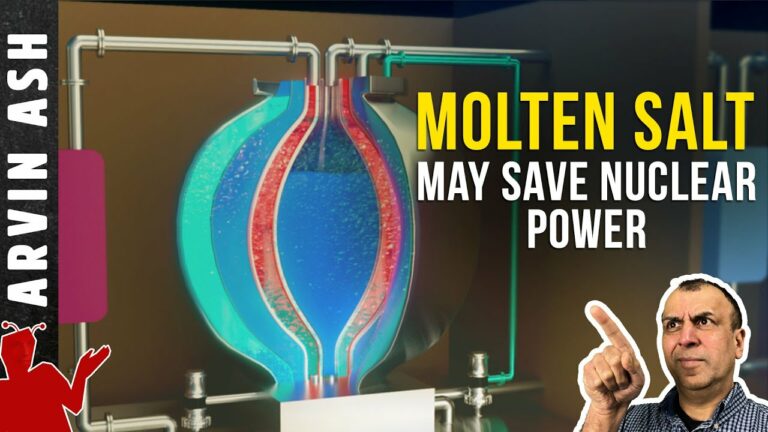Nuclear Power is Dead, Long Live Nuclear Power!
Nuclear energy is a form of energy released from the nucleus, the core of atoms, made up of protons and neutrons. This source of energy can be produced in two ways: fission – when nuclei of atoms split into several parts – or fusion – when nuclei fuse together.
The nuclear energy harnessed around the world today to produce electricity is through nuclear fission, while technology to generate electricity from fusion is at the R&D phase. This article will explore nuclear fission. To learn more about nuclear fusion
What is nuclear fission?
Nuclear fission is a reaction where the nucleus of an atom splits into two or more smaller nuclei, while releasing energy.
For instance, when hit by a neutron, the nucleus of an atom of uranium-235 splits into two smaller nuclei, for example a barium nucleus and a krypton nucleus and two or three neutrons. These extra neutrons will hit other surrounding uranium-235 atoms, which will also split and generate additional neutrons in a multiplying effect, thus generating a chain reaction in a fraction of a second.
Each time the reaction occurs, there is a release of energy in the form of heat and radiation. The heat can be converted into electricity in a nuclear power plant, similarly to how heat from fossil fuels such as coal, gas and oil is used to generate electricity.
There is a technology which could eliminate concerns about nuclear waste and disasters obsolete and allow us to have nearly unlimited energy, molten salt nuclear power technology. How does it work? What makes it safe? And how is it different from conventional nuclear power plants?
Any powerplant uses some fuel to heat some liquid. This liquid can be water, but it doesn’t have to be. This hot liquid can be used in industrial processes, or we can convert it to steam to drive a turbine to create electricity.Then it’s icooled down again to be reused, to continue the cycle.
In a nuclear power plant. the source of energy is from the nuclear process of fission. Fission, very simply put, is when in the core of the reactor, we are split a heavy elements like uranium into smaller elements, like Krypton and Barium. The energy comes from the mass difference between the starting and ending products.
There have been drawbacks to nuclear power: 1) very expensive to build, 2) produces highly radioactive by-products which require storage for long periods of time, 3) an accident can cause an environmental disaster. A molten salt and Thorium reactor can eliminate many of these problems.
In the core of a traditional reactor, the fuel used today is uranium 238 with a tiny amount, uranium 235. But the fuel also has a lot of U238 which transmutes into highly radioactive isotopes, like Plutonium 239. This is the core of the nuclear waste problem.
There are two main differences with a molten salt reactor. Instead of solid fuels, the fuel is dissolved in molten salt which is in liquid form. The second difference is that instead of water as the coolant, they use a second molten salt as the coolant. These have several advantages, and some disadvantages.
The fissile material such as uranium is now part of the salt, which is in liquid form. This can allow it to move and circulate. This is very different from traditional designs where the uranium just sits in the core, and can’t go anywhere.
A circulating molten fuel is better, first, because it’s molten, it operates at much higher temperatures and can carry a lot more heat . And because it doesn’t operate under pressure, there is no chance of pressure vessel failure, so it can’t blow. Furthermore, because the fuel salt is being pumped into the reactor to keep it circulating, if anything goes wrong, for example if the pump stops working, the fuel will simply drain out via gravity into the bottom holding tank.
Molten salt also has a chemical property that when becomes too hot, it naturally expands. This reduces the nuclear chain reactions because the distance between the fissile atoms increases, so the chain reaction slows down all by itself. This is like a built-in thermodynamic safety valve. So in case of trouble, the salt can be just allowed to overheat, and the chain reaction will be reduced by itself. This makes a meltdown virtually obsolete.
Since the fuel is circulating, the reactor does not have to be shut down to be refueled. It can be refueled on the go. Finally, because the core by virtue of using molten salt is very hot, 600+ degrees Celsius, it has much better thermal efficiency. You can thus make more heat with a smaller core. So the reactor is unpressurized and has a smaller footprint, so it costs less to build for a given energy output. The reactor design by Copenhagen Atomics are so efficient and small that the whole thing can fit in a 40-foot container, and be produced on an assembly line, drastically reducing manufacturing cost.
So if molten salt reactors are so great, why are they not everywhere? They are highly corrosive and have not been commercially proven. Copenhagen Atomics has solved the problem by keeping removing the moisture and air from the salt, so that it doesn’t corrode.
Do not forget to share your opinion with us to provide you with the best posts !




0 Comments